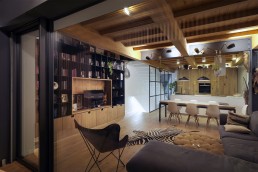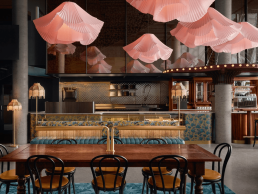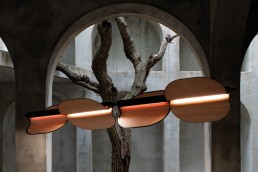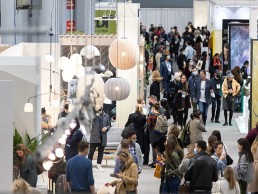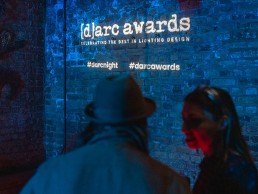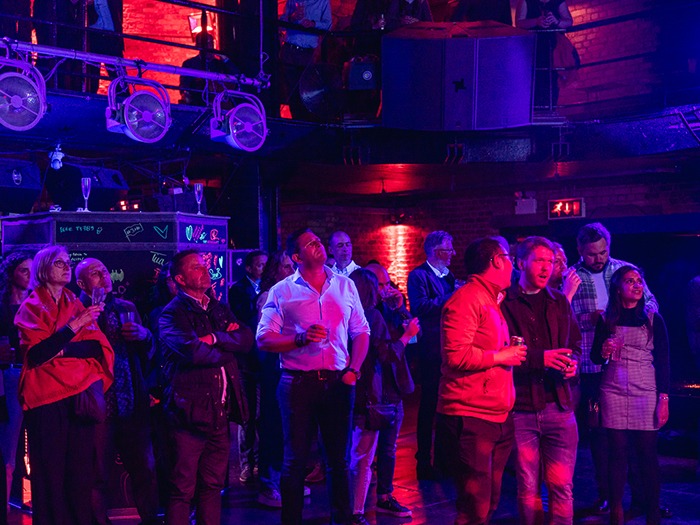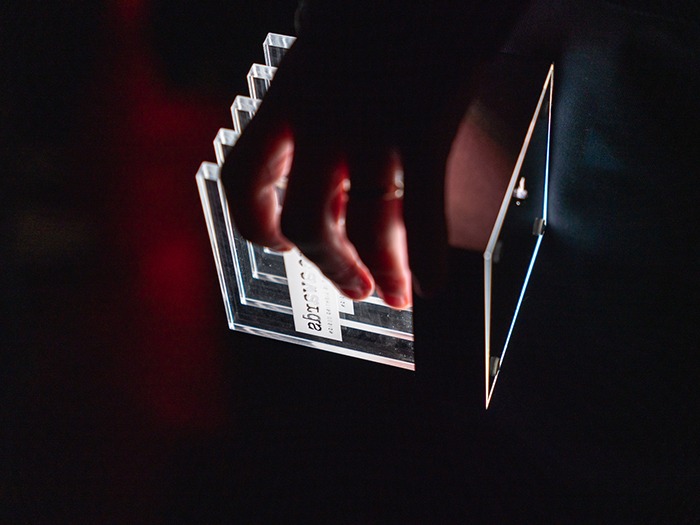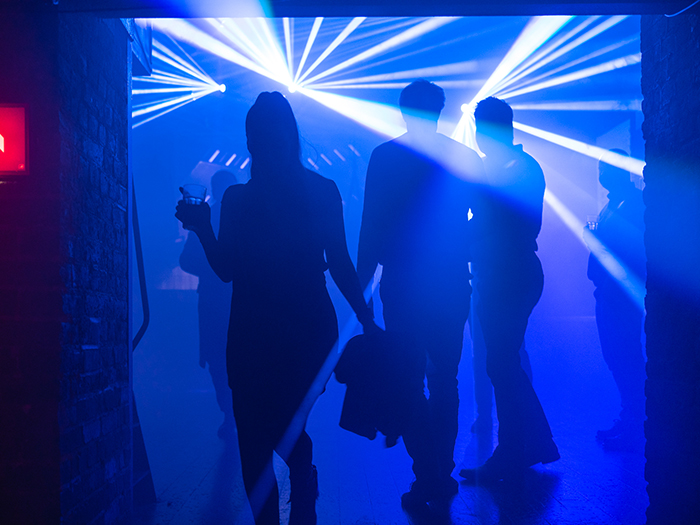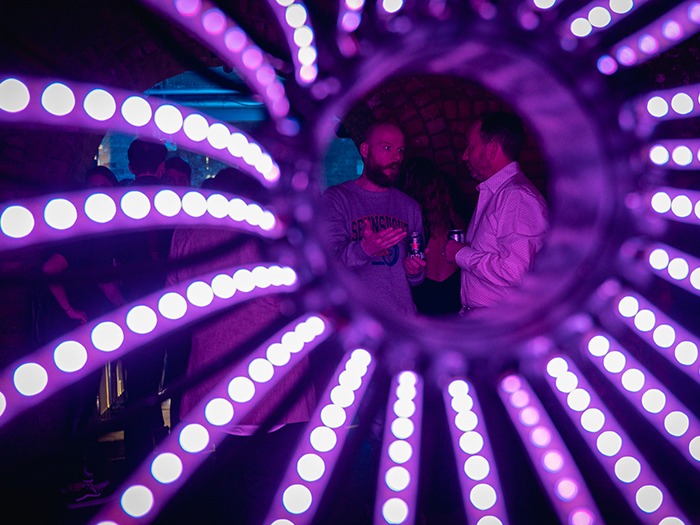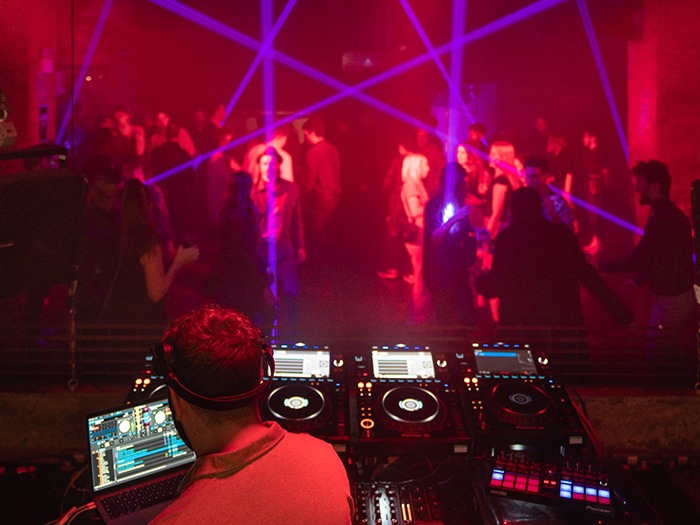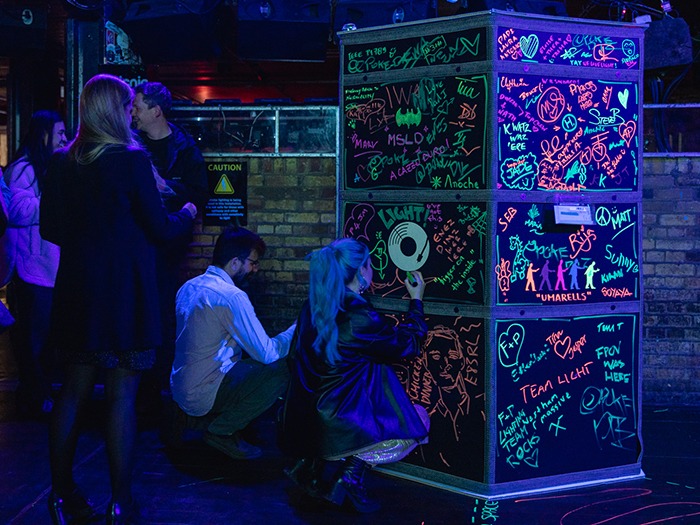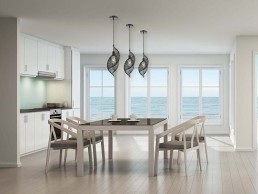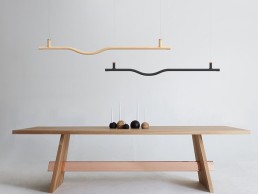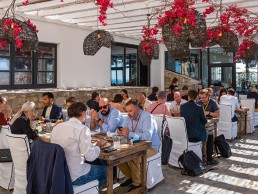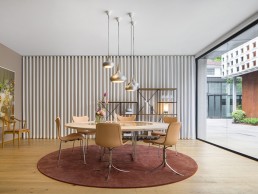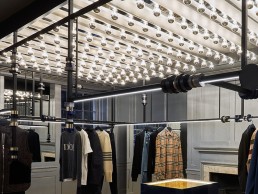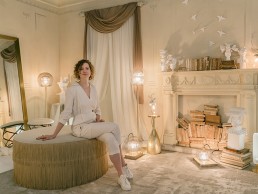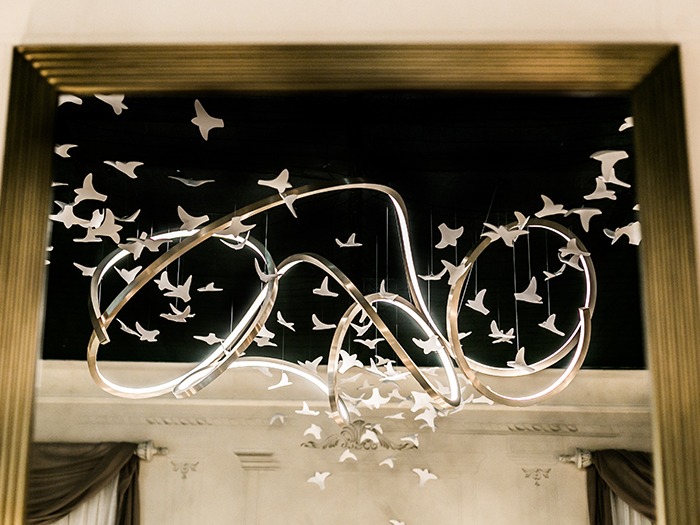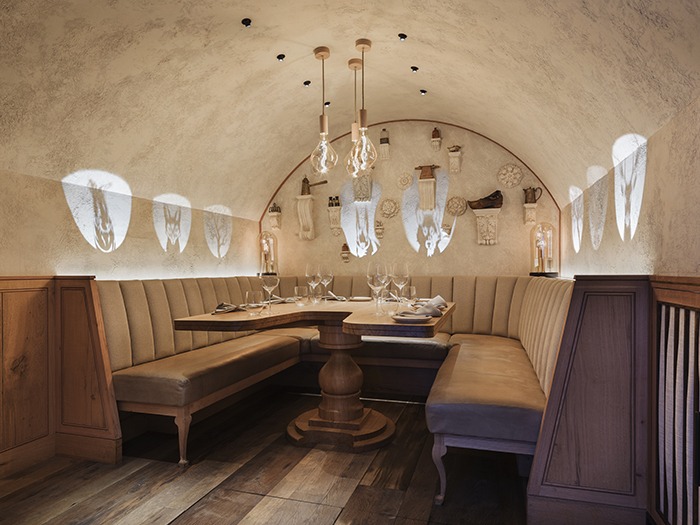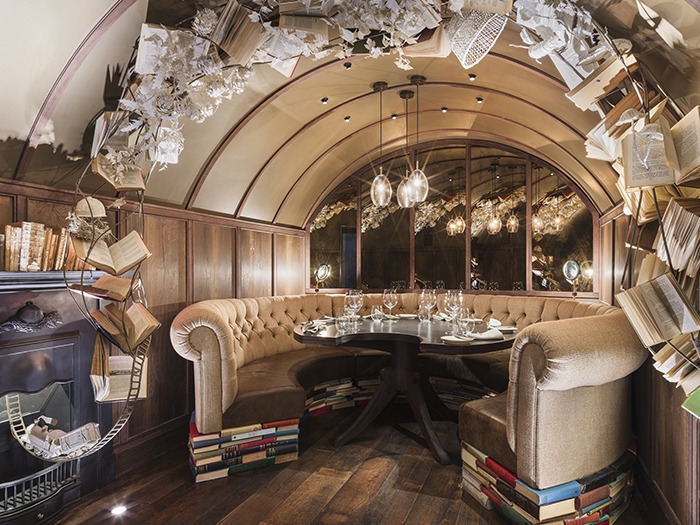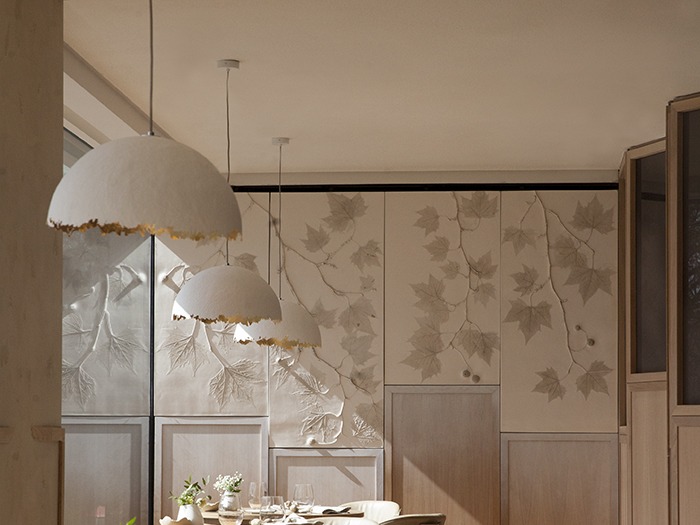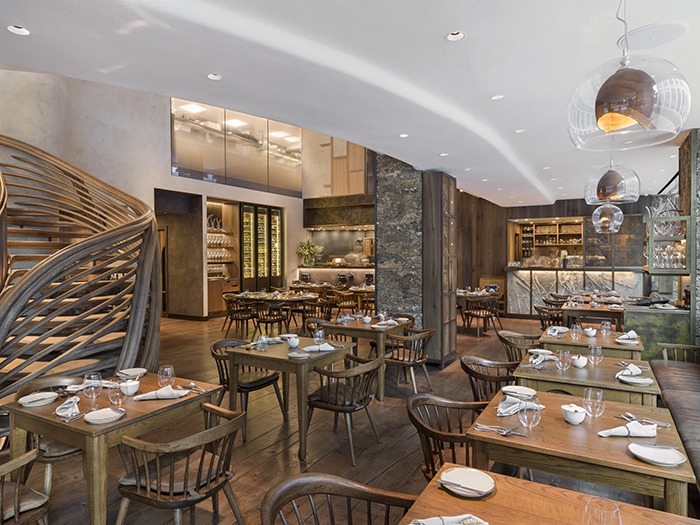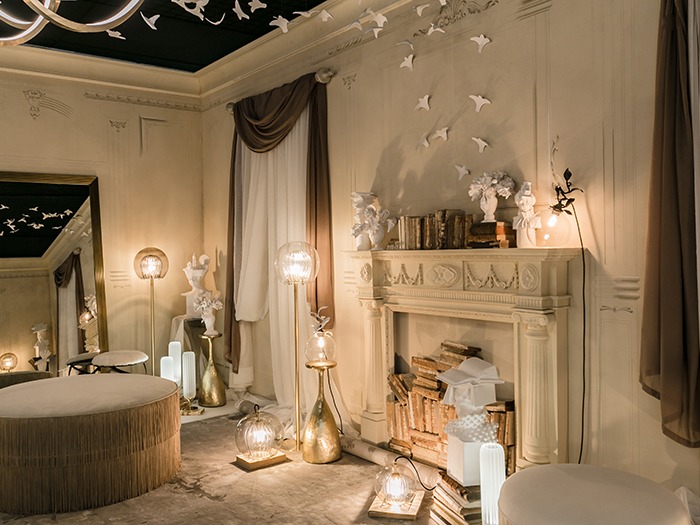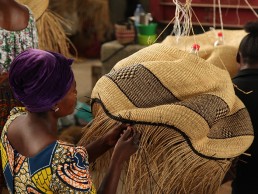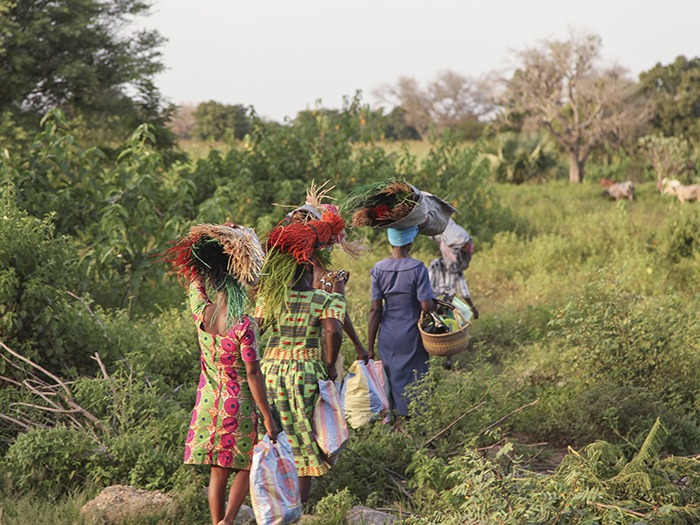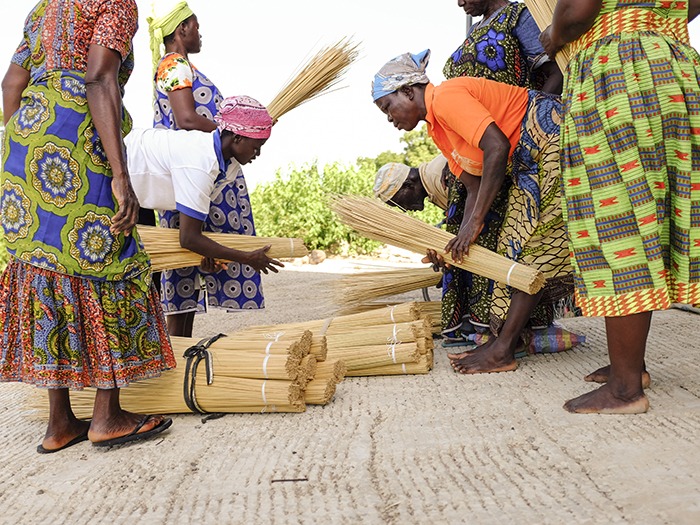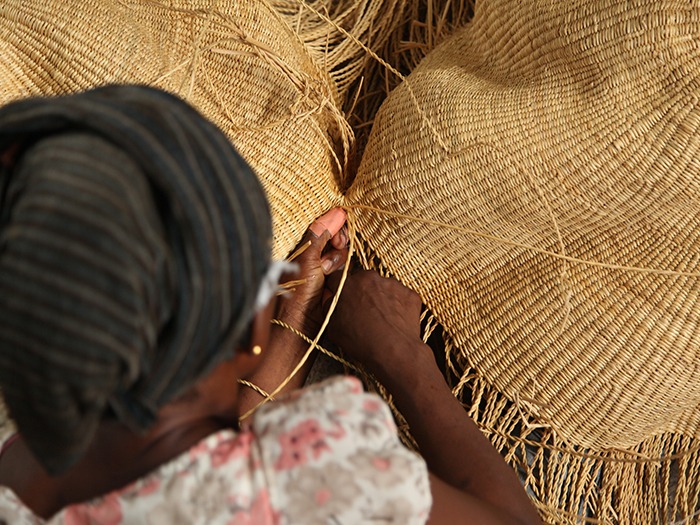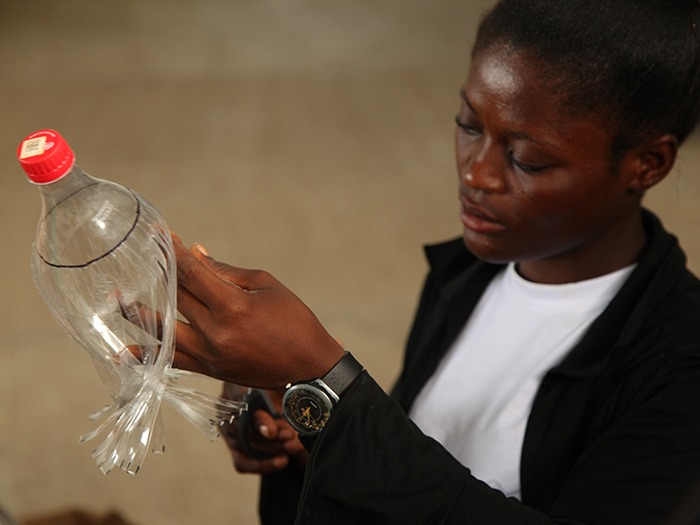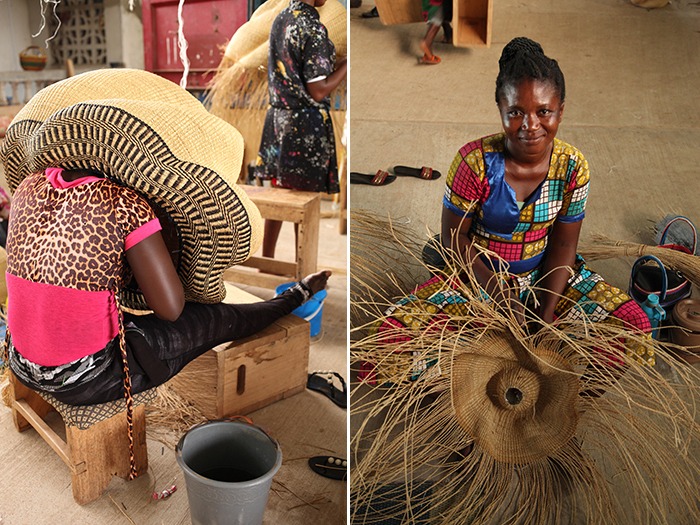The Passive House, Cesena, Italy
The Passive House in Italy was designed by Piraccini + Potente Architettura firm to be the first of its kind in Europe. This required refurbishing an existing building within a dense, urban area while adhering to the international Passive House protocol. To maximise the energy efficiency of the build and reduce its ecological footprint, it was made from a structure of wood, steel, masonry, and reinforced concrete, with each material chosen for its natural characteristics.
A selection of Astro lights are featured throughout to enhance the interior and exterior of the building: the Ginestra 400 and the Osca Round in the living areas, the Bologna 240 in the bathroom and the Eclipse Round in the corridors, the Cabin Wall and Jura single on the outside spaces.
Café Constance, Canada
Canadian design studio Atelier Zébulon Perron has created a café of escapism at the Les Grands Ballet Canadiens institute in Montréal, using bespoke, playful tutu and fringed lighting pieces throughout.
Located in downtown Montréal’s Wilder building, home of Les Grands Ballet Canadiens, is Café Constance, a space for social gatherings. The café, completed in February 2022 by Atelier Zébulon Perron, pays tribute to Constance Pathy, a Member of the Order of Canada, a generous patron of the arts, and former leader of Les Grands Ballets.
The multifunctional space in the lobby welcomes visitors as a meet-and-mingle locale before productions, a traditional café environment for those in the building, and transitions into a cocktail hour evening venue. The main focus of the design was to create something “warm and whimsical in the heart of a contemporary institutional building”.
“We adopted a theatrical approach in order to build a sort of spectacle that is really quite literal,” explains Zébulon Perron, founder and lead designer of the design firm. “The idea was to create something that seems completely out of place, and that captivates the imagination in a strange and wonderful way.”
One of the firm’s primary challenges was to create this stimulating design whilst maintaining a functional space. A more intimate, human-scaled environment was achieved through the addition of a marquise above the bar area. Bevelled glass, mirrors and backlighting on the back bar suggest a theatrical element that is reminiscent of a wardrobe setting, and a dollhouse-esque atmosphere. The Marquise is custom fabricated in powder-coated steel with integrated sockets for dim-to-warm LED Tala Sphere I light sources.
“Café Constance channels elegance, grace, and movement through its tribute to the arts,” says Perron. “Collectively, all of its design elements interact in an eclectic atmosphere with unique character.”
Further adding to the whimsical nature of the space, the design team took inspiration from Muybridge’s famous stop motion sequences and featured custom-designed tutu lamps that flow through the café and taper its expanse to a more intimate scale. These custom-fabricated tutu shades are formed of crinoline and also feature dim-to-warm COB LED light sources. Each blush-coloured shade is unique in shape, which adds to the ethereal flow.
Banquettes and stools upholstered in colourful leather, fringed lampshades, and an antique English communal table further contribute to the magical universe of Café Constance, wrapped in the warm embrace of vivid and lively floral fabrics and wallpaper patterns. These fringed lamps were custom-made in brass tubing and fittings with sockets for dim-to-warm LED Tala lamps and shades sourced from British vendor Lotus Lampshades. The communal “Library” lamp was also custom-fabricated for the venue in brass with integrated dim-to-warm LED lighting and a brass chainette fringe.
“The tongue-in-cheek approach to Café Constance aimed at creating a fun and fantastical space within the more austere backdrop of the building's contemporary architecture,” concludes Zébulon Perron. “That play on contrasts extends to the design within the space as well, with hints of Victorian elements and boudoir intimacy animated by intricate colours, patterns, and light fixtures.”
www.zebulonperron.com
Images: Alex Lesage
LZF - Omma
Designed by Eli Gutiérrez, Omma is an inventive lamp, like a tree with fluttering leaves full of light. In Gutierrez’s prepossessing design, it is almost possible to imagine the lamp’s movable wood veneer, artfully edged with metal, flapping in a gentle breeze. Omma is available as a suspension lamp (with one, two, three, and four leaves), a table lamp (with either one or two leaves), a floor lamp (with a single leaf), and a wall lamp (with a single leaf). Individual leaves will rotate up to 180º, allowing the user to create a range of lighting moods.
The Omma family of lights are available in several wood veneer colours: natural white, natural beech, and natural cherry. The lamp’s metal finishes (used to create the spine and to edge the wood veneer modules) include: matte black, matte ivory, and gold.
ICFF + Wanted Design 2022 talks programme announced
(USA) - ICFF + Wanted Design Manhattan confirm 2022 talks line-up - with Driving Design Change and Social Awareness a focus.
For three days in May, design stars, innovators, and big thinkers take centre stage to provide responsive new ideas, dive into original thinking, and share their belief in design for the greater good. From celebrating power couples and discovering the next generation of design, to the relaunch of the Interiors Awards and presenting the ECO Solidarity winners, the talks programming aims to be a true source of inspiration.
Highlights include:
- Design leader Paola Antonelli shares insights from her latest book, Design Emergency
- The Fair’s Power Couples Series debut features Eric Höweler and Meejin Yoon of Höweler + Yoon, George Yabu and Glenn Pushelberg of Yabu Pushelberg, and Friends & Founders’ Rasmus Hildebrand and Ida Linea Hildebrand
- Inside Norway: Meet the Makers with executives from iconic and upstart brands Dyfosit, Eikund, Fram Oslo, Hadeland Glassverk, Heymat, Figgjo, Lundhs, and Volver
- The ICFF Editors Awards are back and open to all exhibitors
- The Emerging Designers Showcase returns with host Amy Devers from Clever
- Returning this year is the Mentorship program for emerging designers with Be Original Americas
Located on the Talks Main Stage and in Oasis, by Float Studio, the ICFF + WantedDesign Manhattan Talks program is sponsored by Mercato Place and American Standard. The Main Stage is designed with the support of Turf Design, Midgard, and Be Original Americas, and Oasis is sponsored by Gabriel North America, Mohawk Group, and Normann COPENHAGEN. For the second year, designer Rodolfo Agrella was commissioned to create the look and feel for the ICFF + WantedDesign Manhattan Talks Main Stage.
ICFF + Wanted Design Manhattan take place from 15-17 May, 2022 at the Javits Center, New York. For more information head to: icff.com for the full talks programme, click here.
Bath Abbey, UK awarded 2021 [d]arc awards ‘Best of the Best’
(Global) – [d]arc awards prove massive success for seventh year with 550 attendees at Fabric, London.
On the evening of Thursday 31 March 2021, the design community came out in force at Fabric nightclub in London to support the only peer-to-peer lighting design awards in the world and find out which studios had won in this year’s prestigious [d]arc awards.
Sponsored by Applelec; Delta Light; formalighting; iGuzzini; Kingfisher Lighting; Lutron; Rako; Seoul Semiconductor; Tryka and We-ef, Mesh (bar sponsor) and Linea Light Group (photo booth sponsor), an astonishing 15,000 votes from designers were received in total while 262 project entries and 92 product entries were submitted. The 2021 entries came from all over the world, with 42 countries represented this year.
Awarded the coveted [d]arc awards ‘Best of the Best’ for 2021, was Bath Abbey in the UK by Michael Grubb Studio, which won the Places – High Budget category. This award is given to the project that received the most amount of votes out of all the project category winners.
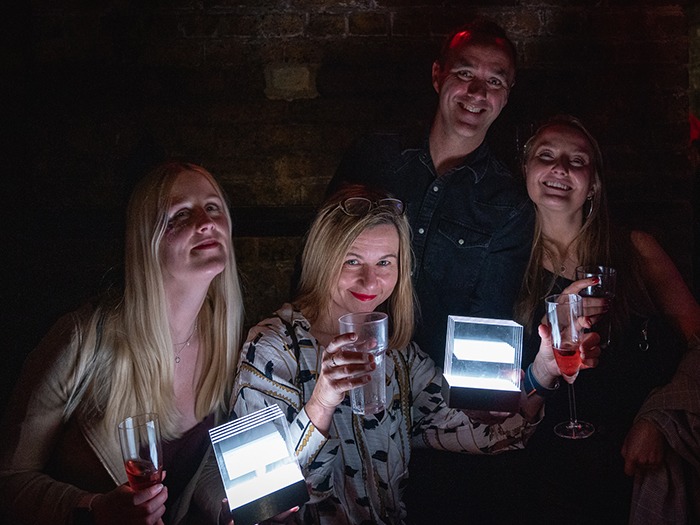
The Bath Abbey Footprint project is a historic £19.3m transformation programme of restoration work that aims to provide contemporary and sustainable solutions to meet the needs of the Abbey.
Commenting on this year’s awards, [d]arc media Managing Director, Paul James couldn’t be happier with how the event has gone, saying: “It was fantastic to hold the [d]arc awards as a live event again. The lighting design profession thrives on face to face interaction so this was a welcome return. To have 550 people at Fabric was great to see! I want to thank everyone that entered, voted and came to the awards ceremony. A special thank you to the sponsors and lighting design partners who put so much effort into the installations. They all looked spectacular and bring something special to the unique format of the [d]arc awards. I can’t wait to do it all again next year!”
Returning as an in-person event for the first time since 2019, [d]arc night proved once more that it is the ‘must-attend’ party for the design community. Held for the second time at the legendary Fabric nightclub in London, alongside the awards presentation, guests enjoyed a night full of entertainment including karaoke, a photo booth, neon face paint as well as DJs, along with complementary food and drink. The event was once again live streamed on Youtube to a wider international audience.
The light installations this year were themed around ‘Songs’ and the nine design teams were all tasked with making their installations as sustainable as possible.
- LDI teamed up with Lutron and Applelec for their installation based on Fireflies by Owl City.
- WSP worked with Seoul Semiconductor and themed their installation on Toploader’s Dancing In The Moonlight.
- Michael Grubb Studio and We-ef also used Dancing in The Moonlight as their inspiration but by the artist Jubel NEIMY.
- Hoare Lea & Kingfisher looked to Deee-Lite’s Groove Is in The Heart.
- Foundry and Delta Light went with The Smiths’ There Is a Light That Never Goes Out.
- Buro Happold and iGuzzini based their installation on Clair De Lune (Moonlight) by Claude Debussy.
- MBLD and formalighting were inspired by Billy Ocean’s Red Light.
- dpa lighting consultants and Tryka went indie with Muse’s Supermassive Black Hole.
- Foster + Partners, along with Rako, turned to Dance into the Light by Phil Collins.
Entries for the 2022 [d]arc awards will open on: Monday 11 April, 2022
For full details on all the project and product winners and further awards information head to: www.darcawards.com
All images: GavriiLux
Franklite launches new product lines
(UK) – Decorative lighting manufacturer further expands its Catalogue 26 with new ranges.
Franklite introduces its new range of products that are not only functional and efficient, but also beautiful and creative.
The Shell is a nautical inspired matte black openwork pendant with black cable suspension. The pendent has been designed to complement spaces that feature coastal elements and wood tones such as shiplap wall panelling.
The Kasteel range features unique twisted metalwork arms; these dark, antique bronze fittings with brushed brass candle tubes consist of two and three light wall brackets along with larger five, eight and 15 light fittings. The four light fitting is supplied with a chain suspension, which can easily be converted to a flush fitting suitable for low ceilings.
The Diva range is exactly that, extravagant! Chrome finish fittings surrounded by rectangular crystals with a mass display of crystal glass spheres as a base. This range includes 11, 15 and 20 light fittings and matching wall bracket. When lit, the colour temperature and reflection of the lamps creates very distinctive ambiences.
New designs have also been added to Franklite’s most popular ranges, the Taper, Perdita, Philly and Wisteria, providing customers with more product choices. The Taper range now includes wall brackets, floor and table lamps. A phenomenal 21 light spanning 1.2m in length has been added to the Wisteria range.
For the full product range head to: www.franklite.co.uk
SBID International Design Awards 2021 Winners Announced
(UK) – The SBID International Design Awards winners revealed for 2021 at Nobu Hotel Portman Square, London.
Shining a spotlight on some of the world’s brightest design talent, the creative A&D community came together in a global celebration of interior design excellence to celebrate the industry’s most revered interior designers and makers.
With categories in Interior Design, Product Design and Fit-Out, this year’s SBID Award winners represent the spectacular displays of creativity, innovation and professional mastery emanating from the international design community.
As a true showcase of the best in global design, winning projects across the Interior Design & Fit Out categories span from a luxury hotel in Budapest, inspiring health retreat in Spain and premier nightlife destination in Singapore, to an innovative airport in Beijing, striking office space in Dubai and captivating beach-side bar in Devon.
This year’s edition saw notable design practices taking home a prestigious SBID Award, including Zaha Hadid Architects, Richmond International, 4SPACE Design, G.A. Group, Rachel Laxer Interiors, Design Command, Cumberland Group, Extreme Design – and many more - featuring well-known brands such as Harrods, Twinings and Four Seasons Hotels & Resorts.
The Overall Winner Award for Interior Design was bestowed upon London-based design studio, Angel O’Donnell for the stunning residential design of an 18th floor apartment in the City.
Winner of this year’s Lighting Product Design category went to Republic of II By IV for the Boga Collection. The Boga Collection offers timeless elegance of nature’s awe-inspiring display of light in the form of a highly sculptural pendant. Boga, which takes its origins from the Old English word “bow” was in-spired by the use of wood, this seamless suspension of light has infi-nite applications. High-quality and innovative, the Boga Collection combines LED technology and high-quality fabrication techniques to create a flawlessly even glow that flows from end to end.
With a commitment to recognising excellence and supporting the wider creative industries, the SBID Awards also announced its specialist annual accolades to punctuate the 2021 edition.
The SBID Master of Design was presented to interior designer, Founder and Creative Director of Firmdale Hotels & Kit Kemp Design Studio, Kit Kemp for her significant contributions in raising the profile of the interior design profession.
With a business empire that spans retail, property, finance and consumer goods, the SBID Fellow of the Year for 2021 was awarded to Theo Paphitis for his outstanding achievements in business, while Darren Summerfield received the Industry Hero award as a respected champion of UK trade for the Kitchen, Bedroom and Bathrooms (KBB) industry in media and publishing.
Finally, Stirling Eco was presented with the exclusive Sustainability & Innovation in Design Award in recognition of their pioneering developments to revolutionise urban travel with high performing electric motorcycles that prioritise the planet.
Inaugural [d]arc sessions a success
(Greece) - Networking event sees top designers and lighting suppliers meet on the beautiful island of Mykonos for two-days of meetings and educational talks.
Making its debut at the beautiful, five-star Royal Myconian Hotel in Mykonos, Greece, [d]arc sessions is a brand-new event organised by [d]arc media in association with Hix, built around connecting people involved in lighting specification projects around the world in an intimate, exclusive setting.
In an era when every business trip must be accounted for, the drive for [d]arc sessions was to get specifiers and suppliers together for a series of one-to-one meetings, away from the hectic hustle and bustle of a typical trade show, where there is no guarantee of who you are going to see.
Held from 5-7 October, a curated guest list of 20 suppliers and 40 specifiers (lighting designers, architects, and interior designers) made the journey to the stunning island of Mykonos for two days of face to face, in-person meetings, networking, and socialising – a welcome relief after 20 months of remote working and webinars.
Over the course of two days, four dedicated Speed+Sync “sessions” saw suppliers and specifiers attend a series of 20-minute meetings where they could sit down and discuss the latest products, projects, trends, and innovations in the industry, with the goal of generating leads, specifying products, and forming new working relationships.
Alongside the Speed+Sync sessions, the event featured a series of panel discussions around some of the industry’s biggest topics. On the first day, Sanjit Bahra, Director of DesignPlusLight, Stephanie Harris, Senior Designer at dpa lighting consultants, and Staffan Tollgård, Creative Director of Tollgård Design discussed design in a post-Covid world and how the global pandemic has impacted on their approaches, if at all.
On the second day, the topic of sustainability and the circular economy was discussed by Filippo Lodi, Associate Director at UNStudio, Laura Suico, Senior Lighting Designer at Foster + Partners, and Gé Hulsmans, Director Specifier Service at eldoLED; the final panel talk saw Rose Murray, Director of These White Walls, Sabine De Schutter, founder of Studio De Schutter and Sanjit Bahra cover issues surrounding equality in the design community. From race to gender and sexuality, the free-flowing, open discussion welcomed participation from the audience, leading to a very positive dialogue about one of the biggest issues in the design community.
The conference programme was capped off by a keynote presentation from Eleftheria Deko, who shared with the audience the story of the incredible, multiple [d]arc award-winning lighting design for the Acropolis of Athens. The inspirational talk was a big hit with the delegates in attendance, who were moved by the passion and enthusiasm that Deko put into this landmark project.
Following the Speed+Sync sessions, the event made use of its five-star surroundings with evening entertainment spread across its multiple restaurants each night. Here, delegates enjoyed exquisite local food, socialised and continued conversations initiated earlier in the day.
On the final evening, additional entertainment came with some traditional Greek plate smashing and sirtaki dancing to the soundtrack of Zorba’s Dance.
Looking back on the event, Paul James, [d]arc media Managing Director, said: “[d]arc sessions was an unmitigated success. I was absolutely delighted with the response from our delegates to this new event in the lighting specification calendar.
“The delegates’ enthusiasm and positivity, coupled with the beautiful surroundings, made [d]arc sessions a pleasure to organise.
“[d]arc sessions is a unique event and a new way to get specifiers and suppliers to network with each other. Based on the feedback, both groups thoroughly enjoyed it and got so much from it.
“We will be organising more [d]arc sessions next year and we are currently looking at new locations, starting in the Middle East. We hope to welcome even more delegates in the future.”
Among the delegates in attendance, Gorazd Malačič, Managing Director at Tokio, said: “[d]arc sessions exceeded our expectations! It was very well organised, set in a beautiful location and with great attendance of high-profile lighting and interior designers. It was a relaxed event where we were able to get the full designers’ attention. We will definitely come back for the second edition!”
Jose Peramo, Key Account Manager at Sakma, added: “We are very surprised about the good result and response, this being our first time at this kind of event. In my opinion, the format is perfect to get in contact with the appropriate people and have the choice to meet with whom you’re really interested in – good talks, good feelings and good vibes.”
Walter Långstedt of Saas Instruments added: “The [d]arc sessions at Mykonos were a great way to kickstart our path towards normality and being able to meet clients face to face. Because it had been 18 months since our last encounter with an international client we were really pumped, and to our delight so was everybody we met during the trip as well. Feedback on our light fittings and projects was really good and we felt the potential for future collaborations was very real. Thanks to darc magazine!”
Amongst the specifiers in attendance, Darren Orrow, Director at into, said: “Well done to [d]arc media and Hix for putting together [d]arc sessions – a seriously well organised event connecting industry leaders in lighting design. Some great new partnerships established over a series of informal meetings, lunches and dinners. The beautiful location and sunshine was a bonus.”
Laura Suico of Foster + Partners added: “It has been an incredible experience, the perfect format and location to share design ideas and new trends for the future. I think the format works really well and the informal context helped the networking a lot, everyone was feeling more relaxed compared to when we are in our offices.” Meanwhile, Rose Murray of These White Walls added: “[d]arc sessions really stood out from the usual ‘conference’ events, and I feel quite honoured to have joined you all – and I have learned more about LED drivers than I knew existed.”
Eleftheria Deko continued: “After the Covid lockdown periods, it was great to be among so many lighting colleagues again, and to also share our journey of the lighting of the Acropolis. I would like to thank the [d]arc media team for the invitation to participate and to share with everyone our experience of this amazing project. A big bravo to the
[d]arc team and everybody involved for all the efforts to bring the lighting community together.”
Images: Gavriil Papadiotis (www.gavriilux.com)
Fritz Hansen opens Chinese showroom
(China)- Danish furniture and lighting brand Fritz Hansen opens its doors to brand-new Shanghai showroom.
Located in ShanKang Li, Jing'an's lifestyle and dining hub, it has been designed in collaboration with Chinese architect group COLORFULL Design and the 220sqm showroom marks the first step in Fritz Hansen’s China expansion.
The space features a curated selection of Fritz Hansen’s most iconic pieces and is decorated in a palette of beige, white and rose, providing an inspirational hub and comprehensive design-source for architects, designers and customers – focusing on balance of functionality and great design.
“Our Shanghai showroom represents a physical manifestation of our brand as we take our steps into the Chinese market. It reflects the evolving vision of a luxury lifestyle brand, first established 150 years ago,” says Dario Reicherl, Fritz Hansen´s CEO of Asia. The new showroom is part of Fritz Hansen’s ambitious international growth strategy as our global footprint continues to expand. Over the coming months, the team will multiply with a dedicated office to cater to the growing Chinese market."
Zico Lighting expands Mirrored Range of LED filament lamps
(UK) – Zico’s new Mirrored Range combines all the benefits of the Zico brand with a beautiful mirror head finish for the ultimate lighting result.
“With over 90 individual lamps in our product portfolio, we are always on a look out for new products to support the lighting designers all over the world,” says James Miller, the company’s Managing Director. “This new range comes in response to requests from our customers. We originally added the silver mirrored GLS lamp to our portfolio as a tester and it has been in demand ever since, supporting showstopping lighting installations such as Browns Fashion in Mayfair. With requests for a gold alternative and other lamp sizes coming in, we feel it’s time to expand to a full range.”
The new Mirrored Range offers customers three traditional lamp shapes: Golfball, GLS and Globe, finished with either metallic silver or warm gold mirrored tops, perfect for use as a feature in an open luminaire producing ambient lighting without glare.
All lamps boast high CRI above 90, are fully dimmable on leading and trailing edge and are compatible with most market leading dimmer brands, with a three-year warranty as standard. The lamps are available for pre-order by contacting Zico Lighting and expected in stock for worldwide deliveries mid-November 2021.
Image reference: Browns Fashion London Mayfair
Photographer: Bozho Gagovski
Design of the retail space led by Dimorestudio
Rose Murray
darc’s Editor Helen Ankers sat down with Rose Murray, Founder of These White Walls interior design studio based in London, UK, to find out more about the all-female led company and its design approach.
Murray has always had a fascination with design and how spaces can “redefine our individual and collective experience” but began her education with a degree in Anthropology and career with an internship at Vogue and then later, styling editorials and television sets for the BBC. “I then moved into the world of immersive events, designing luxury dining spaces and performative events for a more radically-minded corporate clientele,” Murray tells darc.
“It was never my intention to become an interior designer, but when the pop-ups became permanent and I began working with architects, I began to see how my multidisciplinary experience could be applied within the world of interiors to create something different, and that’s how the studio emerged.”
These White Walls was established in 2017 as a direct result of Murray filling a role in the industry she felt it was missing. “My vision was to create a new and more meaningful aesthetic, one that I had not yet encountered in reality,” she explains. “I knew I wanted my work to be transformative and that my approach would combine my three fascinations – narrative, materials and artistry – in order to establish a unique voice in design. That vision has not changed but rather evolved; I learn more about myself through the work. More recently I have articulated the vision as a blank canvas for creativity, whereby I can begin by wiping the slate clean for my clients, start with a blank page and create an entirely new vision of their reality from there.
“I wouldn’t say I have a signature style, but rather a distinct approach towards design: I apply a tripartite approach, exploring the potential of [the previously mentioned] narrative, materials and artistry to work cohesively and establish a new aesthetic.
"Visually, each space has its own style that emerges as a result of the highly personalised approach, working with clients individually, but I can see beneath it is a consistently well considered refinement, and a boldly elegant style that is sometimes difficult to define.”
Working with a core team of four women in the studio, Murray is also supported by a wider team of up to 10 that work remotely, including visualisers and technicians. “Working this way means that our boutique business can offer a highly bespoke service while remaining agile; we can swell and adapt when the workload demands it,” she says. “It feels very organic for me to run the studio this way, as I can keep directing the creative course of our work while retaining a highly personalised approach to the projects.”
Working with an immediate all-female team was not a conscious decision, Murray explains, but more of a natural coincidence. “I love working with women and was lucky enough to be nurtured by many through my early career, before diving into more male-dominated industries,” she says.
“I think that experience has subconsciously driven a desire to give back to young women who are dreaming big in a similar way. I think I attract talented women to the studio because of the strong feminine energy that runs beneath it, but we attract equal numbers of men, so there is no bias behind it – the studio is open to all genders, as long as you are driven to make amazing work its doors are open.”
When asked about her relationship with lighting, it is clear it plays an integral role in Murray's designs. Drawing experience from her previous ventures on film sets and large-scale event spaces, she quickly became aware of how lighting can transform a space and bring it to life. “I discovered how, no matter how beautifully you dressed the space, the magic really happens when the lights are turned on,” she says.
“I also learned a lot of trickery while on set, often toying with refractive surfaces and layered light to create more depth and ambience. That experience has stayed with me over the years, and now I always design with that in mind.
“Lighting should awaken the design concept behind the space; it can do so by layering its own visual narrative on top. Light stimulates the emotions and should enable the user to engage more meaningfully with the space itself and the objects within it. We are all creating experience for those who use the space, and every element within the design should contribute to maximising that potential.”
Murray has also developed a strong understanding of the cohesive relationship between architectural and decorative lighting and how each can influence and work in harmony in a space. “I see the two working synergistically together; architectural lighting is vital for functionality, and equally for enabling us to appreciate the form of space within the building. Architectural lighting can really amplify our experience of space as we move through it. Decorative lighting adds to this in a more overt manner, affecting the ambience in a more characterful way. The two should always complement each other.”
Looking back to the studio’s first major project, HIDE restaurant in Mayfair, UK, the team set their standards high by offering something highly unique at the time. “I knew the project was an opportunity to create something spectacular, and thankfully the clients gave me a great deal of creative freedom to surprise them throughout the process,” says Murray. “It was a total pleasure to be able create so much bespoke – from the dining tables to the drink’s trolleys, to the decorative studio. Every detail makes me proud and that level of detail is the reason that we have attracted a global clientele from that foundation.”
Working with lighting designers Speirs and Major, the teams brought the HIDE design concept to life, in particular in the private dining areas, as Murray notes: “The Shadow Room was an interesting example, as the room was very much defined by playful projections that appear throughout the dining experience. Since then, we have moved to working more directly with lighting manufacturers to design bespoke objects as well as large scale installations. One of our current projects involves a 10-metre bespoke gilded glass chandelier that responds to stimulus within the space. It aims to capture natural elements and translate them into an interactive form. I can’t reveal more than that at present, but I am excited to see the design unfolding.”
Continuing the discussion about her role as a female designer supported by an immediate all-female team, darc asked how supportive the design industry of female designers was and what Murray's personal experience has been like.
“Working in film, events and commercial hospitality design – particularly from construction level upwards – has meant that I have spent most of my adult life working in male-dominated industries. Being the only female in the room meant that I had to learn to speak up and stand my ground sooner than I might have otherwise experienced.
“It can be tough to be taken seriously, particularly as a young female, but it also teaches you resilience. I learned to speak with certainty and enough integrity to convince those around me to work towards that same goal. No matter what gender you are, if you are brave enough to stand up and inspire others around you, and offer a vision beyond what already exists, then you will always receive the support you need to achieve it.”
With attitudes changing, in large part thanks to initiatives such as Women in Lighting, one way Murray feels the industry can continue to support women within design is to “remain open and collaborative and by creating platforms for other women to showcase their work beside your own, will help greatly.”
Referring to HIDE as an example again, Murray explains how she found space to commission three female artists to create site-specific artworks that responded to the design concept and interior architecture. “I worked closely with each of these women, observing the nascent works, discussing the right materials and helping to guide some of the forms to ensure the works remained in harmony with the wider vision, but ultimately it was an opportunity for them to shine and create their own work within that same space. The result was mutually supportive and a great success for us all.”
Reflecting on the recent impacts the global pandemic of Covid-19 has created, Murray sums up the importance of questioning everything: “we should apply this same approach toward addressing the underlying constructs that cause inequality in our industry. The industry has faced tough times this year with the global Covid crisis, which has affected everyone at some level. The response so far has widely been to override our differences for the sake of survival, and the community is emerging far stronger and more collaboratively as a result.
“We must hold onto this lesson once the pandemic passes, continue to work together rather than apart, and embrace technology as a great enabler to achieve this,” she concludes.
Fighting the war on plastic
First presented at the Galleria Rossana Orlandi in 2011, AcDO's PET Lamp project continues to grow from strength to strength. darc takes a closer look at what the studio is trying to achieve through its latest lamp series originating in Ghana.
Nine years ago, in the summer of 2011, industrial designer Álvaro Catalán de Ocón (ACdO studio) was invited by fellow designer Hélène Le Drogou to be part of a project focused on the reuse of PET plastic bottles. With a growing quantity of plastic waste still invading every corner of the planet, in many locations there are insufficient resources to collect and recycle the waste and in tropical zones this problem has a unique aggravating factor. The tropical rains wash PET plastic bottles into the rivers, which in turn take them out to the sea. Once there, the bottles float on the ocean currents and despite the size of this problem no country has yet taken responsibility.
The starting point for ACdO on how best to reuse the PET plastic bottles was the profound contradiction hidden in every bottle – it has a very useful, yet short life compared to the time it takes for the materials to decompose, not to mention the energy used in its production and when applicable, in its recycling. While views are slowly changing on the use of single-use plastics, PET is still a widely used product as it is undeniably effective, cheap and practical. Around 100 million PET plastic bottles are used daily, of which only one out of every five is recycled. The rest become litter, go to landfills or end up in the ocean, polluting our ecosystem; it takes 700 years for a PET plastic bottle to start decomposing.
ACdO’s objective was to think about the validity of the object in the long-term, and to prevent it from becoming obsolete after just a few minutes. The right use of the bottle would allow it to be transformed into a coherent, functional and desirable product. Inspiration for how best to use the bottles came from analysing the bamboo stirrer used in the Japanese bamboo tea ceremony, as both objects have many elements in common; they are both made from a single material and in one piece. Furthermore, their form has a structural element and a flat surface that can be spun; weaving on this warp, the piece acquires and maintains its desired form. Analysing the bottle as an industrial piece, we can see in it traces of its manufacturing process, the lines where the moulds meet serve as horizontal and vertical references for cutting and spinning.
It is possible for PET bottles to have a second life and so ACdO looked to fuse one of the most widely produced industrial objects with a traditional craft, rooted to the earth – basketry and weaving, transforming the bottles from containers for liquids into ceiling lamps.
Basket making emerged as a response to the human need for receptacles for storing, transporting food and so on, and unlike PET bottles, traditional basketry uses materials that decay naturally. While many other crafts have become mechanised, as yet, no one has invented a machine that can make baskets.
The ACdO design team took advantage of the bottle top to join the electrical components to the lamp shade, with the neck becoming the structure, and the body of the bottle a surface on which to weave. The principal of weaving is reinterpreted and the surface of the bottle is converted into the warp through which the artisan weaves the weft.
The aim of ACdO’s project was not only to produce an attractive and desirable contemporary object mixing basket weaving and reused PET plastic bottles, but also to establish a working method full of anthropological overtones, defending the importance of maintaining the traditional techniques of different ancestral places, giving artisans freedom to express themselves, while introducing the studio’s own vision of their work and techniques. This approach has led to the identity, tradition and handcrafted techniques of each culture that has participated in the PET lamp project since 2011, being imprinted on each lamp.
Different types of basketry has been explored over the past nine years - from coiled basketry in Ethiopia and Chile, which uses grasses and rushes; plaiting, a technique used by Columbian artisans, which uses materials that are wide and ribbon-like such as palms or yucca; twining, which the studio explored in Australia and uses materials from roots and fresh palm leaves; wicker baskets come from willow and are masterfully used by the Chilean artisans in the Chimbarongo region. Then you have artisans in Thailand that are specialised in bamboo basketry techniques, characterised by its controlled production process.
Having already created six PET Lamp ceiling collections working with artisans all over the world, Bolgatanga, one of the most remote towns in Ghana, was the location chosen to develop the PET Lamp 2019 project. In the heart of the Upper East Region and just a few kilometres from Burkina Faso, Bolgatanga is known as the ‘city of baskets’ and is also the capital of the Gurunsi people, who have lived and controlled this territory along with small parts of southern Burkina Faso and northwest Togo, for centuries.
The importance given to basket weaving in this territory is one of the main reasons why ACdO decided to head to this remote corner of Africa to develop a new PET Lamp. Traditional basket weaving is regarded not only as a tool for day-to-day life and a livelihood for the people there, it also helps to provide greater social cohesion and embodies the values expressed in their culture. All this makes basketry the biggest industry in the region.
There, ACdO found the perfect partner for its collaborative project: The Baba Tree Basket, a company set up by Gregory MacCarthy, that has promoted and preserved the traditional basket weaving work of the Gurunsi community for over 15 years. The Baba Tree community is made up of over 250 artisans who weave with local straw and Elephant grass, the most popular basket weaving material used in northern Ghana - imported from the wetter south of Ghana. They mix in each piece the Gurunsi weaving traditions with an up-to-date and more modern language thanks to the introduction of the waves characteristic of this process, giving each basket a unique dynamism and rhythm.
Each and every master weaver the studio collaborated with and who continue to weave these lamps leaves their own imprint and style on their pieces, to make a collection that is full of unique details and features. Each lamp poses a new challenge for them, where they can give living form to a vital part of their culture and display it on a global market.
The concept for these lamps consisted of getting the weavers to also use another technique from India. The artisans use the Elephant grass and a type of traditional knot common in their baskets and made a series of pleats by strategically duplicating the warp at certain points of the weaving process. The outcome is that the excess material is then forced to find its natural shape by forming large folds. These new lamps hold a lot of presence in a room, with ACdO deciding to keep their natural colour so as to accentuate the pleats. They have a black border with traditional designs to give an elegant finish that also respects the traditions of their craft.
A second collection is also being developed – a selection of smaller lamps that can be combined with the other collections, this time in the brilliant colours that are the hallmark of Baba Tree baskets.
"This workshop was one of the most rewarding we have worked on to date," says ACdO. "Discovering a country full of surprises we were able to enjoy a close and easy-going relationship with the artisans, from whom we have learnt the secrets of a technique full of riches. The experience also allowed us to open a window and enable them to update their traditional basketry by integrating PET bottles, which is a real and ongoing problem in this part of Ghana."


